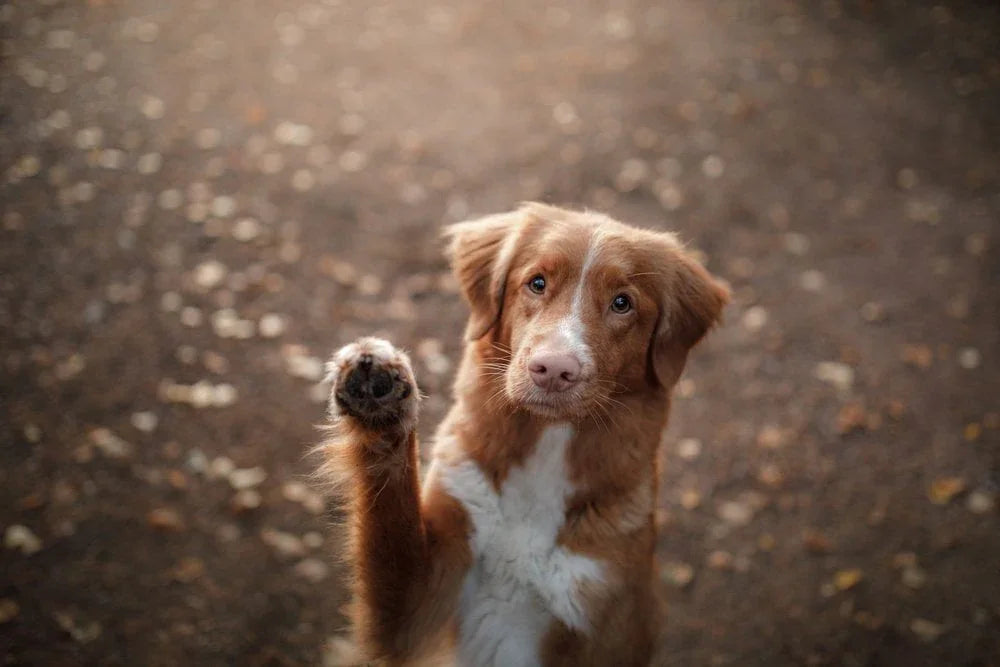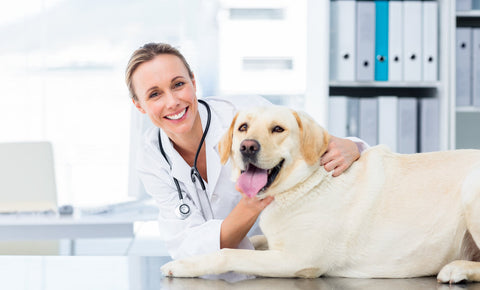

Dog paw infections: Causes, symptoms and treatment
Is your dog licking or chewing one paw more than usual? Maybe they’re limping or trying to nibble between their toes? While there are many possible causes, a paw infection could be to blame, and it’s time to take a closer look.
What is a dog paw infection?
A paw infection happens when bacteria, fungi (like yeast) or parasites invade and damage the skin. Normally, your dog’s skin acts as a tough, waterproof barrier. But if it’s irritated, injured, or the immune system isn’t working properly, these invaders – even some that naturally live on the skin – can overgrow or get into deeper layers where they don’t belong. That’s why paw infections are often secondary to another issue.
You might also come across the term pododermatitis:
Podo = foot
Derm = skin
Itis = inflammation
In short, pododermatitis just means inflammation of the skin on the feet. It doesn’t always mean there’s an infection, but the two often go hand in hand.
Signs and symptoms of a dog paw infection

While what you can see will vary depending on the severity and cause, here are some of the tell-tale signs of a paw infection:
- Persistent licking, chewing, or nibbling at a paw
- Limping or sensitivity when the paw is touched
- Redness and swelling
- Cracked or peeling pads
- Bad smells or visible pus
- Discoloured fur, reddish from saliva staining or dark and greasy from yeast
- Splayed toes, due to swelling between them, or puffy nail beds
Causes of dog paw infections
Because some bacteria, yeasts and even low numbers of demodex mites live harmlessly on the skin, infections usually occur when the skin barrier or immune system is compromised. For example:
- Moisture – Constant dampness (from water or licking) weakens the skin, making overgrowth more likely
- Allergies – Some allergies (environmental or food-related allergies in dogs) cause inflamed, itchy paws
- Injuries – Cuts, grazes, chemical irritants, burns, or grass seeds can break the skin
- Underlying health conditions – Hormonal imbalances can affect skin resilience
- Conformation issues – Dogs with splayed feet may have regular hairy skin contacting the ground when they walk, instead of only their tough pads
How to treat a dog paw infection at home

If you’ve spotted a mild issue – like after a long, soggy hike – there are a few simple steps you can try at home:
- Gently clean the paw twice a day: Use a saltwater solution (½ tsp of salt in one cup of boiled, cooled water). Avoid harsh products that could further irritate or damage the skin
- Dry the paw thoroughly: Dab rather than rub to avoid causing more irritation
- Skip the bandages: Badly applied bandages can create new problems! Dog socks or boots can help limit licking in the short term, but they can also trap moisture and make things worse
- Stick to short lead walks: It's a tricky balance. You don’t want your pup getting bored and obsessing over the paw, but infected feet need a rest. Keep activity light while they heal
- Avoid human creams: Dogs often lick them off, which can lead to swallowing harmful ingredients, and more licking means more irritation
- For mild yeast infections: Consider a diluted apple cider vinegar rinse (1 part vinegar to 3 parts water), but only if the skin isn’t raw or broken
- Take a photo to track progress: It’s much easier to spot improvement (or deterioration) that way. If redness, swelling, or discomfort is getting worse, it’s time to see your vet
Dog paw yeast infection: Causes and solutions
Look out for a sweet, musty smell and dark-brown or black greasy residue, tell-tale signs of a yeast infection. The most common culprit is Malassezia, a yeast that naturally lives on dog skin. In warm, damp conditions – or if the immune system is compromised – it can overgrow. Even after successful treatment, a new yeast infection can occur if the underlying cause isn’t well controlled.
Most yeast infections respond well to topical treatments like medicated wipes or shampoos. For stubborn or widespread cases, your vet may recommend oral antifungal tablets.
While people with oral yeast infections are sometimes advised to cut carbs, this doesn’t really apply to skin issues in dogs. A high-quality, balanced diet can support skin health and reduce allergens, but it’s unlikely to directly affect yeast growth on the skin.
Preventing dog paw infections
Keeping paws healthy doesn’t have to be complicated. Just follow these basics:
Inspect paws regularly, especially after walks in grass, mud, or on salty roads.
- Protect with balm if your dog walks a lot on rough ground or in more extreme temperatures
- Wash and dry paws after wet or off-road walks to remove irritants and prevent excess moisture buildup
- Support skin health with a balanced diet and allergy control
- Act early, don't wait for a minor irritation to turn into an infection
When to see a vet for a dog paw infection

Even with the best home care, some paw infections get worse. If you’re trying at-home treatment first, take clear photos to track progress, but keep a close eye out for these signs that it’s time to visit your vet:
- Symptoms worsen or don’t improve after 48 hours
- More than one paw is affected
- Your dog is limping. This is a sign of more severe pain
- Not sure what to look for? Check out our blog "How do I know if my dog is in pain"
- Pus or bleeding
- Strong smells even after cleaning
- Recurring infections
Your vet may recommend medicated shampoos, wipes, or creams. Tablets are usually reserved for more severe infections; remember, antibiotics only target bacteria.
One of the most important things your vet can provide is pain relief and anti-inflammatory treatment. Licking is often triggered by pain or irritation and can make infections worse.
If there’s no clear injury or cause, your vet might suggest tests like skin scrapes, swabs, or blood work to identify exactly what is causing the infection and look for underlying issues, such as allergies, hormonal imbalances, or immune disorders.
Keeping your dog’s paw healthy
Your pup’s paws take a beating every day, but a little care goes a long way. Here’s what to remember:
Check paws regularly – especially after wet or rough walks:
- Keep them clean and dry
- Act quickly if you spot swelling, irritation, or limping
- Support overall skin health with good nutrition and allergy care
- Know when to call the vet – early treatment is key to preventing complications
Most dog paw infections are easily managed with the right care, so catch it early, and you’ll quickly be adventuring together again.



